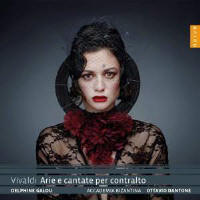Texte paru dans: / Appeared in: |
|
|
Reviewer: Raymond
Tuttle This is, believe it or not, the 60th release in Naïve’s Vivaldi Edition. The Edition is focused on works, many of them previously unrecorded, that are housed in the National University Library of Turin. However, most of these particular arias and cantatas have been recorded previously, and some of them earlier in the Edition. For example, the aria from Tieteberga was recorded by mezzo Ann Hallenberg in Volume 27, well more than a decade ago. There also are complete recordings of Il giustino and La verità in cimento within the Edition. The only arias that might be first recordings are those from La Candace (1720), but I am not even certain of that. I mention this not to dissuade anyone from acquiring the present release (because it is very good) but simply as a public service announcement.
This is a showcase for Vivaldi, but of course it also is a showcase for Delphine Galou, who is French and now in her 40s. She is a Baroque specialist, although she also has appeared in operas by Britten and Ravel. Her voice is rich—in fact, in its upper regions it is surprisingly brilliant in sound—but not matronly or butch. In fact, she could pass for a star countertenor. In the arias, she sings material assigned to either male or female characters, and she is convincing in both. She does some amusing vocal acting in Damira’s aria from La verità in cimento, a selection which annotator Cesare Fertonani describes as “positive and reassuring.” This is odd, because in comically acidulous asides, Damira tells us that we would be crazy if we believed her! We also feel her skin crawling in the second recitative of “Cessate, omai cessate,” as she sings of “dreadful caverns” and “mute horrors.” She sounds marvelously untaxed by Vivaldi’s writing throughout this disc.
The arias and cantatas obviously have been chosen not only for their quality but also for their variety. Dramatic situations alternate with relaxation and serenity. Accademia Bizantina is kept busy by Vivaldi’s willingness to have his instrumentalists enter into the fray. The horns, for example, make a brave noise in “Ombre nere,” the first aria in Qual in pioggia dorata.
| |
|
|
|
|
|
|
|
Cliquez l'un ou l'autre
bouton pour découvrir bien d'autres critiques de CD |
|




